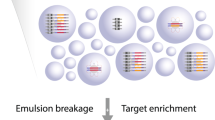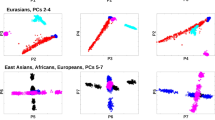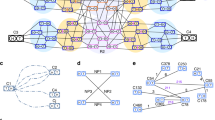Abstract
We present a simple and efficient method for constructing high resolution physical maps of large regions of genomic DNA based upon sampled sequencing. The physical map is constructed by ordering high density cosmid contigs and determining a sequence fragment from each end of every clone. The resulting map, which contains 30–50% of the complete DNA sequence, allows the identification of many genes and makes possible PCR amplification of virtually any part of the genome. We apply this strategy to the automated analysis of the genome of the primitive eukaryote Giardia lamblia and evaluate its applicability to the physical mapping and DNA sequencing of the human genome.
This is a preview of subscription content, access via your institution
Access options
Subscribe to this journal
Receive 12 print issues and online access
$209.00 per year
only $17.42 per issue
Buy this article
- Purchase on Springer Link
- Instant access to full article PDF
Prices may be subject to local taxes which are calculated during checkout
Similar content being viewed by others
References
Schwartz, D. & Cantor, C. Separation of yeast chromosome-sized DNAs by pulsed field gradient electrophoresis. Cell 37, 67–75 (1984).
Cox, D.R. et al. Radiation hybrid mapping: a somatic cell genetic method for constructing high-resolution maps of mammalian chromosomes. Science 250, 245–250 (1990).
Bellanne-Chantelot, C. et al. Mapping the whole human genome by fingerprinting yeast artificial chromosomes. Cell 70, 1059–1068 (1992).
Poustka, A.M. & Lehrach, H. Jumping libraries and linking libraries; The next generation tools in mammalian genetics. Trends Genetics 2, 174–179 (1986).
Coulson, A. et al. Toward a physical map of the genome of the nemotode Ceanorhabditus elegans. Proc. natn. Acad. Sci. U.S.A. 83, 7821–7825 (1986).
Hoheisel, J.D. et al. High resolution cosmid and P1 maps spanning the 14 Mb genome of the fission yeast S.pombe. Cell 73, 109–120 (1993).
Mott, R. et al. Algorithms and software tools for ordering clone libraries: application to the mapping of the genome of Schizosaccharomyces pombe. Nucl. Acids Res. 21, 1965–1974 (1993).
Kohara, Y. et al. The physical map of the whole E. coil chromosome: application of a new strategy for rapid analysis and sorting of a large genomic library. Cell 50, 495–508 (1987).
Olson, M.V. et al. Random-clone strategy for genomic restriction mapping in yeast. Proc. natn. Acad. Sci. U.S.A. 83, 7826–7830 (1986).
Riles, L. et al. Physical maps of the six smallest chromosomes of Saccharomyces cerevisiae at a resolution of 2.6 kilobase pairs. Genetics 134, 81–150 (1993).
Mizukami, T. et al. A 13 kb resolution cosmid map of the 14 Mb fission yeast genome by nonrandom sequence-tagged site mapping. Cell 73, 121–32 (1993).
Foote, S. et al. The human Y chromosome: overlapping DNA clones spanning the euchromatic region. Science 258, 60–66 (1992).
Chumakov, I. et al. Continuum of overlapping clones spanning the entire human chromosome 21q. Nature 359, 380–387 (1992).
Burland, V. et al. DNA sequence and analysis of 136 kilobases of the Escherichia coli genome: organizational symmetry around the origin of replication. Genomics 16, 551–561 (1993).
Daniels, D.L. et al. Analysis of the Escherichia coli genome: DNA sequence of the region from 84.5 to 86.5 minutes. Science 257, 771–778 (1992).
Plunkett, G.3. et al. Analysis of the Escherichia coli genome. III. DNA sequence of the region from 87.2 to 89.2 minutes. Nucl. Acids Res. 21, 3391–3398 (1993).
Oliver, S.G. et al. The complete DNA sequence of yeast chromosome III. Nature 357, 38–46 (1992).
Martin-Gallardo, A. et al. Automated DNA sequencing and analysis of 106 kilobases from human chromosome 19q13.3. Nature Genet. 1, 34–39 (1992).
Wilson, R.K. et al. Nucleotide sequence analysis of 95 kb near the 3′ end of the murine T-cell receptor alpha/delta chain locus: strategy and methodology. Genomics 13, 1198–1208 (1992).
Wilson, R. et al. 2.2 Mb of contiguous nucleotide sequence from chromosome III of C. elegans. Nature 368, 32–38 (1994).
Adams, M.D. et al. Complementary DNA sequencing: expressed sequence tags and human genome project. Science 252, 1651–1656 (1991).
Adams, M.D. et al. Sequence identification of 2,375 human brain genes. Nature 355, 632–634 (1992).
Adams, M.D. et al. 3,400 new expressed sequecne tags identify diversity of transcripts in human brain. Nature Genet. 4, 256–267 (1993).
Polymeropoulos, M.H. et al. Chromosomal distribution of 320 genes from a brain cDNA library. Nature Genet. 4, 381–386
Olson, M. et al. A common language for physical mapping of the human genome. Science 245, 1434–1435 (1989).
Green, E.D. et al. Systematic generation of sequence-tagged sites for physical mapping of human chromosomes: application to the mapping of human chromosome 7 using yeast artificial chromosomes. Genomics 11, 548–564 (1991).
Smith, M.W. et al. A sequence-tagged site map of human chromosome 11. Genomics 17, 699–725 (1993).
Evans, G.A. & Lewis, K.A. Physical mapping of complex genomes by cosmid multiplex analysis. Proc. natn. Acad. Sci. U.S.A. 86, 5030–5034 (1989).
Altschul, S.F. et al. Basic local alignment search tool. J. molec. Biol. 215, 403–410 (1990).
Pearson, W.R. & Lipman, D.J. Improved tools for biological sequence comparison. Proc. Natl. Acad. Sci., USA 85, 2444–2448 (1988).
Uberbacher, E.C. & Mural, R.J. Locating protein-coding regions in human DNA sequences by a multiple sensor-neural network approach. Proc. natn. Acad. Sci. U.S.A. 88, 11261–11265 (1991).
Weissenbach, J. et al. A second-generation linkage map of the human genome. Nature 359, 794–801 (1992).
Kieleczawa, J. et al. DNA sequencing by primer walking with strings of contiguous hexamers. Science 258, 1787–1791 (1992).
Strathmann, M. et al. Transposon-facilitated DNA sequencing. Proc. natn. Acad. Sci. U.S.A. 88, 1247–1250 (1991).
Deaven, L.L. et al. Construction of human chromosome-specific DNA libraries from flow sorted chromosomes. Cold Spring Harbor Symp. Quant. Biol. 51, 159–167 (1986).
Fan, J.B. et al. Giardia lamblia: haploid genome size determined by pulsed field gel electrophoresis is less than 12 Mb. Nucl. Acids Res. 19, 1905–1908 (1991).
Adam, R.D. The biology of Giardia spp. Microbiol. Rev. 55, 706–732 (1991).
Sogin, M.L. et al. Phylogenetic meaning of the kingdom concept: an unusual ribosomal RNA from Giardia lamblia. Science 243, 75–77 (1989).
Evans, G.A. et al. High efficiency vectors for cosmid microcloning and genomic analysis. Gene 79, 9–20 (1989).
Holberton, D. et al. Segmented alpha-helical coiled-coil structure of the protein giardin from the Giardia cytoskeleton. J. molec. Biol. 204, 789–795 (1988).
Aggarwal, A. et al. A heat shock protein gene in Giardia lamblia unrelated to HSP70. Nucl. Acids Res. 18, 3409 (1990).
Soderlund, C.A. et al. in Proceedings of the 26th Hawaii International Conference on System Sciences: Biotechnology Computing. (ed. Hunter, L.) 620–630 (CA: IEEE Computer Society Press, 1993).
Soderlund, C.A. & Burks, C. GRAM and genfragII: solving and testing the single-digest partially-ordered restriction map problem. Comp. Appl. Biol. Sci. (in the press).
Saiki, R.K. et al. Primer-directed enzymatic amplification of DNA with a thermostable DNA polymerase. Science 239, 487–491 (1988).
Cohen, D. et al. A first-generation physical map of the human genome. Nature 366, 698–701 (1993).
Coulson, A. et al. Genome linking with yeast artificial chromosomes. Nature 335, 184–186 (1988).
Baxendale, S. et al. A cosmid contig and high resolution restriction map of the 2 megabase region containing the Huntington's disease gene. Nature Genet. 4, 181–6 (1993).
Ansorge, W. et al. High-throughput automated DNA sequencing facility with fluorescent labels at the European Molecular Biology Laboratory. Electrophoresis 13, 616–619 (1992).
Drmanac, R. et al. DNA sequence determination by hybridization: a strategy for efficient large-scale sequencing. Science 260, 1649–1652 (1993).
Drury, H.A. et al. A graphical user interface for quantitative Imaging and analysis of electrophoretic gels and autoradiograms. Biotechniques 12, 892–898 (1992).
Sambrook, J. et al. Laboratory cloning: a laboratory manual. A.2.I (Cold Spring Harbor Press, New York, 1988).
Feinberg, A.P. & Vogelstein, B. Addenddum. A technique for radiolabeiing DNA restriction endonuclease fragments to high specific activity. Anal. Biochem. 137, 266–267 (1984).
Church, G.M. & Gilbert, W. Genomic sequencing. Proc. natn. Acad. Sci. U.S.A. 81, 1991–1995 (1984).
Doolittle, R.F. & Feng, D.-F. in Molecular evolution: computer analysis of protein and nucleic acid sequences, (ed. Doolittle, R.F.) 659–669 (Academic Press, New York, 1990).
Feng, D.-F. & Doolittle, R.F. in Molecular evolution: computer analysis of protein and nucleic acid sequences, (ed. Doolittle, R.F.) 375–387 (Academic Press, New York, 1990).
Clark, S.P. et al. in Biocomputing: Genome sequence analysis (ed. Smith, D. W.) 13–49 (Academic Press, New York).
Stallings, R.L. et al. Evaluation of a cosmid contig physical map of human chromosome 16. Genomics 13, 1031–1039 (1992).
Fonstein, M. et al. Physical map of the genome of Rhodobacter capsulatus SB 1003. J. Bacteriol. 174, 4070–4077 (1992).
Tynan, K. et al. Assembly and analysis of cosmid contigs in the CEA-gene family region of human chromosome 19. Nucl. Acids Res. 20, 1629–1636 (1992).
Lander, E.S. & Waterman, M.S. Genomic mapping by fingerprinting random clones: a mathematical analysis. Genomics 2, 231–239 (1988).
Author information
Authors and Affiliations
Rights and permissions
About this article
Cite this article
Smith, M., Holmsen, A., Wei, Y. et al. Genomic sequence sampling: a strategy for high resolution sequence–based physical mapping of complex genomes. Nat Genet 7, 40–47 (1994). https://doi.org/10.1038/ng0594-40
Received:
Accepted:
Issue Date:
DOI: https://doi.org/10.1038/ng0594-40
This article is cited by
-
Assembling a physical map of the genome by marker sequences
Journal of Forestry Research (2000)
-
HOSEpipE—a WWW-hosted data management and analysis system for STS content mapping projects
Mammalian Genome (1997)
-
The EXT2 multiple exostoses gene defines a family of putative tumour suppressor genes
Nature Genetics (1996)
-
Selective amplification of protein-coding regions of large sets of genes using statistically designed primer sets
Nature Biotechnology (1996)
-
Coincidence cloning
Molecular Biotechnology (1996)



